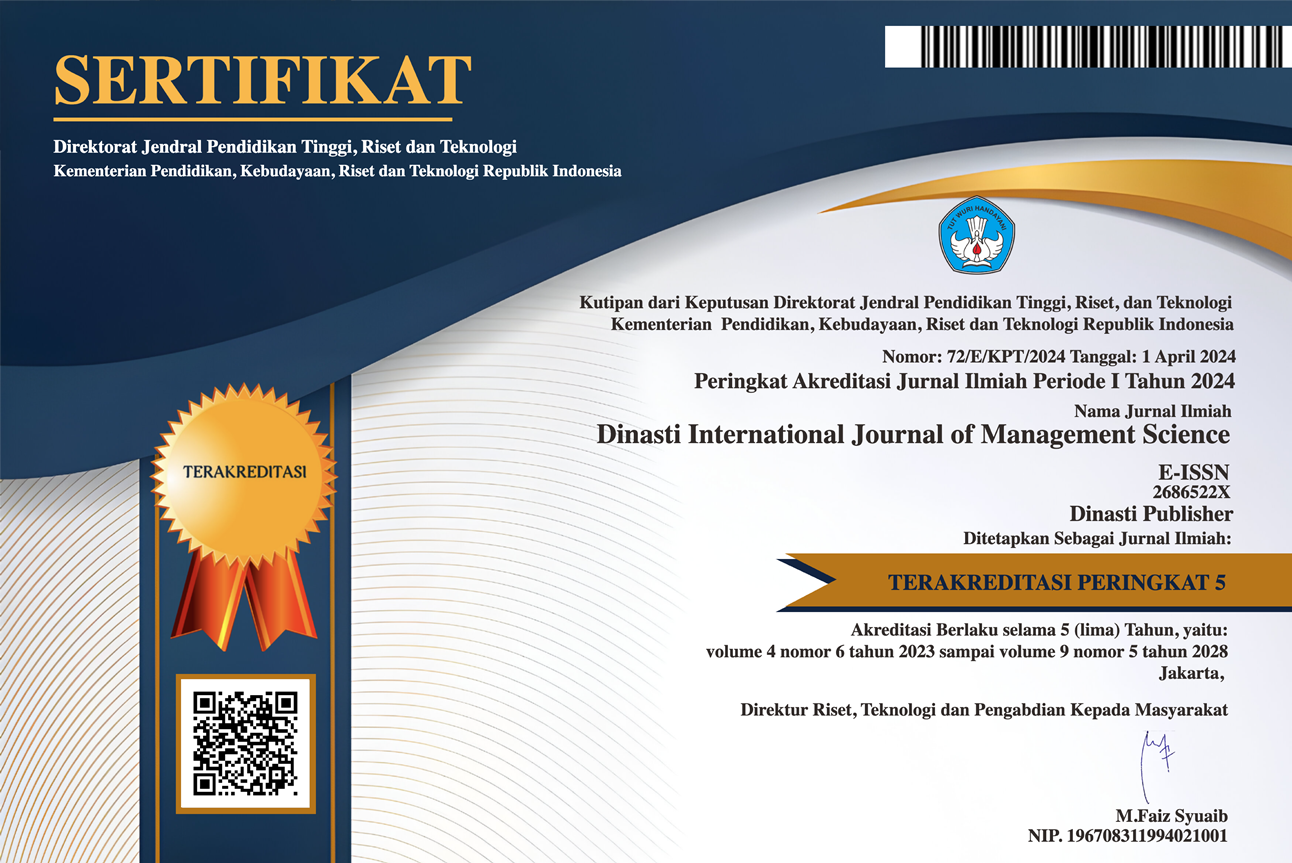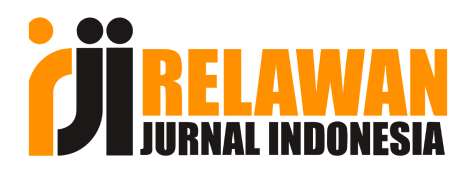Export Market Orientation as Mediation between Entrepreneurial Orientation and Learning Orientation on Export SME Performance
DOI:
https://doi.org/10.31933/dijms.v5i5.2621Keywords:
Entrepreneurship, Learning, Market, SME, Export PerformanceAbstract
This research is about the role of Export Market Orientation as mediation of Entrepreneurship Orientation and Learning Orientation on Export SME Performance in Indonesia. The main phenomenon is the total contribution of non-oil and gas exports (SMEs) which has a tendency to stagnate or even decrease since 2015 of 15.73%, then in 2019 it becomes 14.38%, far from the target set by the government at 17%, this is due to the lack of Indonesian UKM products interested in the global market. This causes the products of Indonesian SMEs to be unable to compete with SMEs of other countries in terms of export earnings. There are many factors that can cause this to happen, such as: lack of good standardization, many entrepreneurs only cater to the domestic market because they do not understand how to export, limited competent human resources and lack of access to financial institutions. Due to the limitations of the research model, especially those studying exports in developing countries, research using a quantitative approach with the SEM-PLS data analysis method is considered appropriate. The choice of the SEM-PLS method, because this research is predictive in nature, will of course be able to better represent the research model. In this study, there were 84 SMEs respondents who were registered with the Ministry of SMEs and Cooperatives. The results revealed that export market orientation had an effect as a mediating relationship between learning orientation and the performance of export SMEs, however, in an indirect relationship between entrepreneurial orientation and export performance, the mediating role of export market orientation not significant. This confirms that information related to export data needs good collaboration between company owners and employees.
References
Adiningsih Sri. (2011). Regulasi dalam Revitalisasi Usaha Kecil dan Menengah di Indonesia. Akademika, 18(2), 150–153.
Asian Development Bank. (2020). Asia Small and Medium-Sized Enterprise Monitor 2020:Volume I-Country and Regional Reviews. In ADB Asian Development Bank (Vol. 1, Issue October). https://www.adb.org/publications/asia-sme-monitor-2020-country-regional-reviews%0Ahttps://www.adb.org/sites/default/files/publication/646146/asia-sme-monitor-2020-volume-1.pdf%0Ahttps://www.adb.org/publications/asia-sme-monitor-2020-country-regional-revie
Barney, J. (1991). Firm Resources and Sustained Competitive Advantage. Journal of Management, 17(1), 99–120. https://doi.org/10.1177/014920639101700108
Barney, J. B. (2001). Resource-based theories of competitive advantage: A ten-year retrospective on the resource-based view. Journal of Management, 27(6), 643–650.
Baron, R. M., & Kenny, D. A. (1986). The Moderator-Mediator Variable Distinction in Social Psychological Research. Conceptual, Strategic, and Statistical Considerations. Journal of Personality and Social Psychology, 51(6), 1173–1182. https://doi.org/10.1037/0022-3514.51.6.1173
BPS. (2009). Badan Pusat Statistik-Klasifikasi Industri.
Cadogan, J. W., Boso, N., Story, V. M., & Adeola, O. (2016). Export strategic orientation–performance relationship: Examination of its enabling and disenabling boundary conditions. Journal of Business Research, 69(11), 5046–5052. https://doi.org/10.1016/j.jbusres.2016.04.078
Chang, Y. S., & Fang, S. R. (2015). Enhancing Export Performance for Business Markets: Effects of Interorganizational Relationships on Export Market Orientation (EMO). Journal of Business-to-Business Marketing, 22(3), 211–228. https://doi.org/10.1080/1051712X.2015.1081014
Covin, Jeffrey, G., & Slevin, Dennis, P. (1989). Strategic management of small firms in hostile and benign environments. Strategic Management Journal, 10(1), 75–87. file:///C:/Users/Ichiyanagi/Downloads/Strategic_Management_of_Small_.pdf
Ferreira, J., Coelho, A., & Moutinho, L. (2020). Dynamic capabilities, creativity and innovation capability and their impact on competitive advantage and firm performance: The moderating role of entrepreneurial orientation. Technovation, 92–93(February 2017), 0–1. https://doi.org/10.1016/j.technovation.2018.11.004
Fornell, C., & Larcker, D. F. (1981). Fornell, C. and Larcker, D.F. (1981), “Evaluating structural equation models with unobservable variables and.pdf. XVIII(February), 39–50.
Frishammar, J., & Andersson, S. (2009). The overestimated role of strategic orientations for international performance in smaller firms. Journal of International Entrepreneurship, 7(1), 57–77. https://doi.org/10.1007/s10843-008-0031-9
G. T. Lumpkin. (1996). the Entrepreneurial Clarifying It Construct and Linking Orientation. Academy of Management Review, 21(1), 135–172.
Hair, J. F., Hult, G. T. M., Ringle, C. M., & Sarstedt, M. (2017). A Primer on Partial Least Squares Structural Equation Modeling (PLS-SEM). In SAGE Publications (Second, Issue 2). https://doi.org/10.1080/1743727x.2015.1005806
Hair Jr, Joe F, Sarstedt, M., Hopkins, L., & G. Kuppelwieser, V. (2014). Partial least squares structural equation modeling (PLS-SEM): An emerging tool in business research. European Business Review, 26(2), 106–121. https://doi.org/10.1108/EBR-10-2013-0128
Hair, J. F., Hult, G. T. M., Ringle, C. M., & Sarstedt, M. (2017). A Primer on Partial Least Squares Structural Equation Modeling (PLS-SEM). In SAGE Publications (Second, Issue 2). https://doi.org/10.1080/1743727x.2015.1005806
Hair Jr, Joseph F, Hult, G. T. M., Ringle, C. M., & Sarstedt, M. (2021). A primer on partial least squares structural equation modeling (PLS-SEM). Sage publications.
Hamdan, H., Yuliantini, T., Raharja, I., Samudro, A., & Ali, H. (2023). Establishing collaborate and share knowledge as a fear of missing out (FOMO) response in improving tourist travel agency innovation performance. BISMA (Bisnis Dan Manajemen), 16(1), 115–143. https://doi.org/10.26740/bisma.v16n1.p115-143
Henseler, J., Hubona, G., & Ray, P. A. (2016). Using PLS path modeling in new technology research: Updated guidelines. Industrial Management and Data Systems, 116(1), 2–20. https://doi.org/10.1108/IMDS-09-2015-0382
Henseler, J., Ringle, C. M., & Sarstedt, M. (2015). A new criterion for assessing discriminant validity in variance-based structural equation modeling. Journal of the Academy of Marketing Science, 43(1), 115–135. https://doi.org/10.1007/s11747-014-0403-8
Herath, H. M. A., & Mahmood, R. (2017). Strategic orientations and SME performance: Moderating effect of absorptive capacity of the firm. Asian Social Science, 10(13), 95–107. https://doi.org/10.5539/ass.v10n13p95
Imran, M., Aziz, A., & Abdul Hamid, S. N. (2017). Determinants of SME export performance. International Journal of Data and Network Science, 1(2017), 39–58. https://doi.org/10.5267/j.ijdns.2017.1.007
Lestari, E. R., Ardianti, F. L., & Rachmawati, L. (2018). Firm performance model in small and medium enterprises (SMEs) based on learning orientation and innovation. IOP Conference Series: Earth and Environmental Science, 131(1). https://doi.org/10.1088/1755-1315/131/1/012027
Mamun, A. Al, Mohiuddin, M., Fazal, S. A., & Ahmad, G. Bin. (2018). Effect of entrepreneurial and market orientation on consumer engagement and performance of manufacturing SMEs. Management Research Review, 41(1), 133–147. https://doi.org/10.1108/MRR-04-2017-0102
Miller, D. (1983). The Correlates of Entrepreneurship in Three Types of Firms. Management Science, 29(7), 770–791. https://doi.org/10.1287/mnsc.29.7.770
Murray, J. Y., Gao, G. Y., Kotabe, M., & Zhou, N. (2007). Assessing measurement invariance of export market orientation: A study of Chinese and non-Chinese firms in China. Journal of International Marketing, 15(4), 41–62. https://doi.org/10.1509/jimk.15.4.41
Nguyen, V. K., Natoli, R., & Divisekera, S. (2021). Innovation and productivity in tourism small and medium enterprises: A longitudinal study. Tourism Management Perspectives, 38, 100804.
Nikraftar, T., & Momeni, S. (2017). The effects of entrepreneurial orientation, market orientation and learning orientation on performance of ICT business. International Journal of Management Concepts and Philosophy, 10(4), 378. https://doi.org/10.1504/ijmcp.2017.087263
Nitzl, C., Roldan, J. L., & Cepeda, G. (2016). Mediation analysis in partial least squares path modeling: Helping researchers discuss more sophisticated models. Industrial Management & Data Systems.
Novari, E. (2020). The SMEs performance: Mediation of ambitious entrepreneur. International Journal of Psychosocial Rehabilitation, 24(8), 4828–4839.
Porters, M. E. (1991). The Competitive Advantage of Nations. Journal of Management, 17(1), 213–215. https://doi.org/10.1177/014920639101700113
Rasbin. (2019). Rasbin Strategi Meningkatkan Ekspor Produk-Produk Usaha Mikro Kecil dan Menengah Indonesia STRATEGI MENINGKATKAN EKSPOR PRODUK-PRODUK USAHA MIKRO KECIL DAN MENENGAH INDONESIA: STUDI KASUS DI KABUPATEN SLEMAN DAN KOTA SURABAYA STRATEGIES TO IMPROVE THE EXP. 2(1), 149–158.
Rezaei, J., & Ortt, R. (2018). Entrepreneurial orientation and firm performance?: the mediating role of functional performances Management Research Review Article information?: Management Research Review, May 2018. https://doi.org/10.1108/MRR-03-2017-0092
Rua, O., França, A., & Fernández Ortiz, R. (2017). Key drivers of SMEs export performance: the mediating effect of competitive advantage. Journal of Knowledge Management, 22(2), 257–279. https://doi.org/10.1108/JKM-07-2017-0267
Sarstedt, M., Hair Jr, J. F., Nitzl, C., Ringle, C. M., & Howard, M. C. (2020). Beyond a tandem analysis of SEM and PROCESS: use of PLS-SEM for mediation analyses! International Journal of Market Research, 62(3), 288–299.
Sarstedt, M., Ringle, C. M., & Hair, J. F. (2017). Partial Least Squares Structural Equation Modeling. In Handbook of Market Research (pp. 1–40). Springer International Publishing. https://doi.org/10.1007/978-3-319-05542-8_15-1
Sawaean, F. A. A., & Ali, K. A. M. (2020). The impact of entrepreneurial leadership and learning orientation on organizational performance of SMEs: The mediating role of innovation capacity. Management Science Letters, 10(2), 369–380. https://doi.org/10.5267/j.msl.2019.8.033
Taherdoost, H. (2018). Sampling Methods in Research Methodology; How to Choose a Sampling Technique for Research. SSRN Electronic Journal, 5(2), 18–27. https://doi.org/10.2139/ssrn.3205035
Tambunan, T. T. H. (2021). EXPORT OF INDONESIAN MSEs AND THE ROLE OF PARTNERSHIP. Journal of Developing Economies, 6(2), 235. https://doi.org/10.20473/jde.v6i2.28747
Teece, D. J., Gary, P., & Shuen, A. (1997). dynamic capabilities and strategic management. Strategic Management Journal, 63(1), 13–23. https://doi.org/10.1176/appi.psychotherapy.2009.63.1.13
Uhlaner, L. M., van Stel, A., Duplat, V., & Zhou, H. (2013). Disentangling the effects of organizational capabilities, innovation and firm size on SME sales growth. Small Business Economics, 41(3), 581–607.
Wahyono, & Hutahayan, B. (2021). The relationships between market orientation, learning orientation, financial literacy, on the knowledge competence, innovation, and performance of small and medium textile industries in Java and Bali. Asia Pacific Management Review, 26(1), 39–46. https://doi.org/10.1016/j.apmrv.2020.07.001
Wheelen, T. L., Hunger, J. D., Hoffman, A. N., & Bamford, C. E. (2017). Strategic management and business policy (Vol. 55). pearson Boston.
Wolff, J. A., Pett, T. L., & Ring, J. K. (2015). Small firm growth as a function of both learning orientation and entrepreneurial orientation: An empirical analysis. International Journal of Entrepreneurial Behaviour and Research, 21(5), 709–730. https://doi.org/10.1108/IJEBR-12-2014-0221
Yulisa, P. A., & Permana, D. (2022). Analysis Effect of Omni Channel on The Msme’s Performance in Craft Industry through Customer Experience and Customer Relationship Management. International Humanities and Applied Sciences Journal (IHASJ), 3(3), 19-27. https://doi.org/10.22441/ihasj.2020.v3i3.03
Downloads
Published
How to Cite
Issue
Section
License
Copyright (c) 2024 Indra Raharja; Hamdan Hamdan, Deden Kurniawan

This work is licensed under a Creative Commons Attribution 4.0 International License.
Authors who publish their manuscripts in this journal agree to the following conditions:
- The copyright on each article belongs to the author(s).
- The author acknowledges that the Dinasti International Journal of Management Science (DIJMS) has the right to be the first to publish with a Creative Commons Attribution 4.0 International license (Attribution 4.0 International (CC BY 4.0).
- Authors can submit articles separately, arrange for the non-exclusive distribution of manuscripts that have been published in this journal into other versions (e.g., sent to the author's institutional repository, publication into books, etc.), by acknowledging that the manuscript has been published for the first time in the Dinasti International Journal of Management Science (DIJMS).
















































